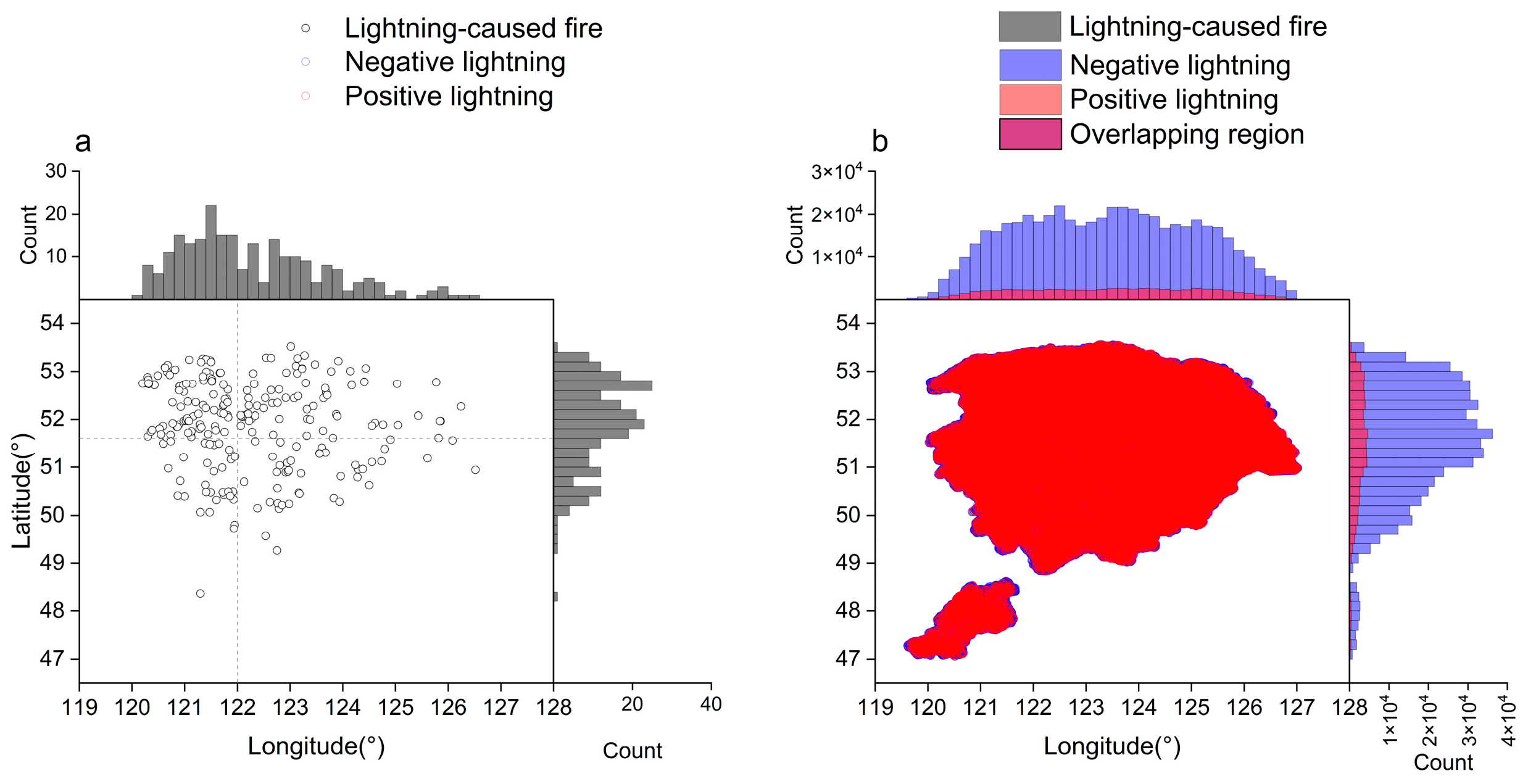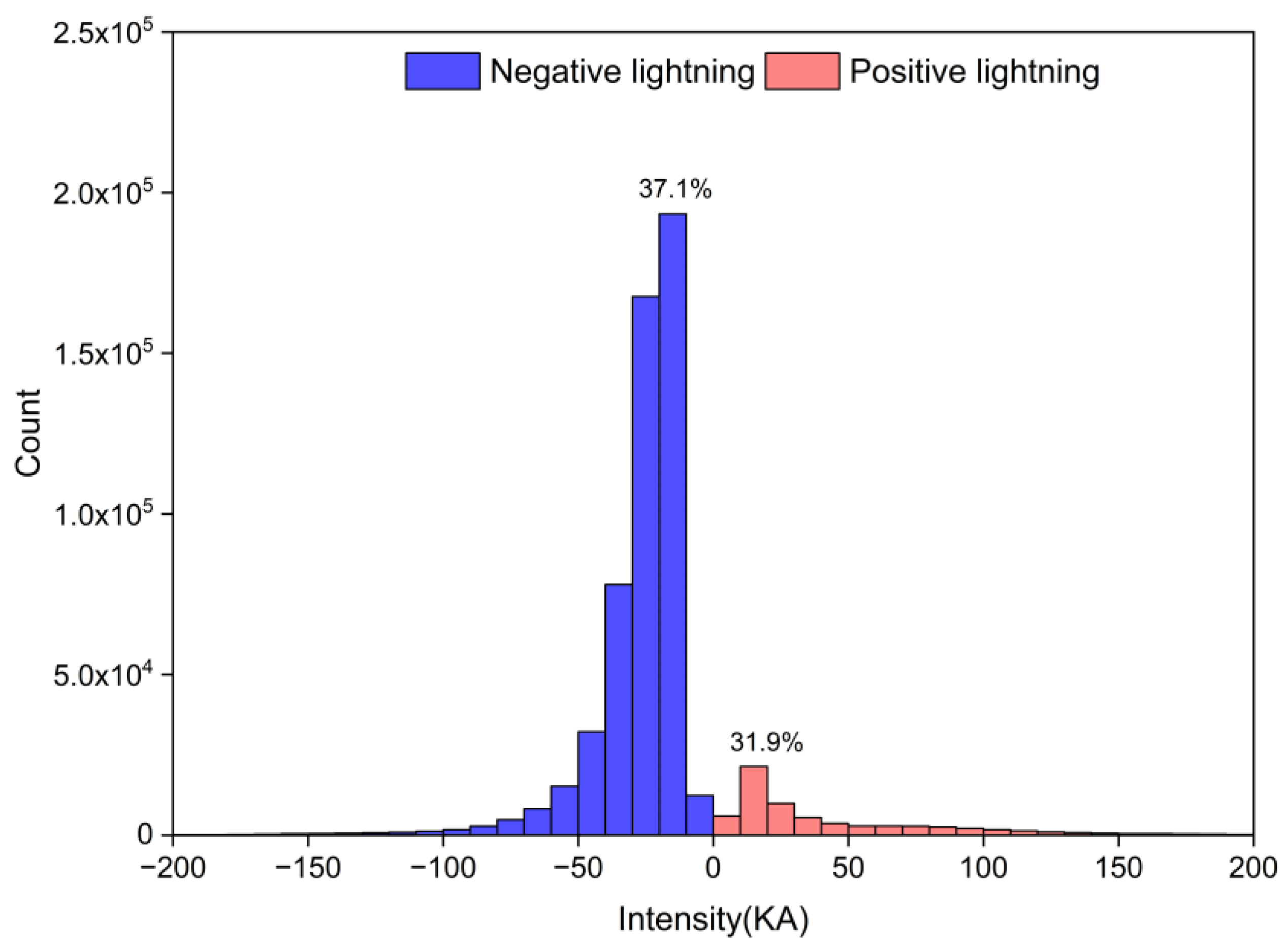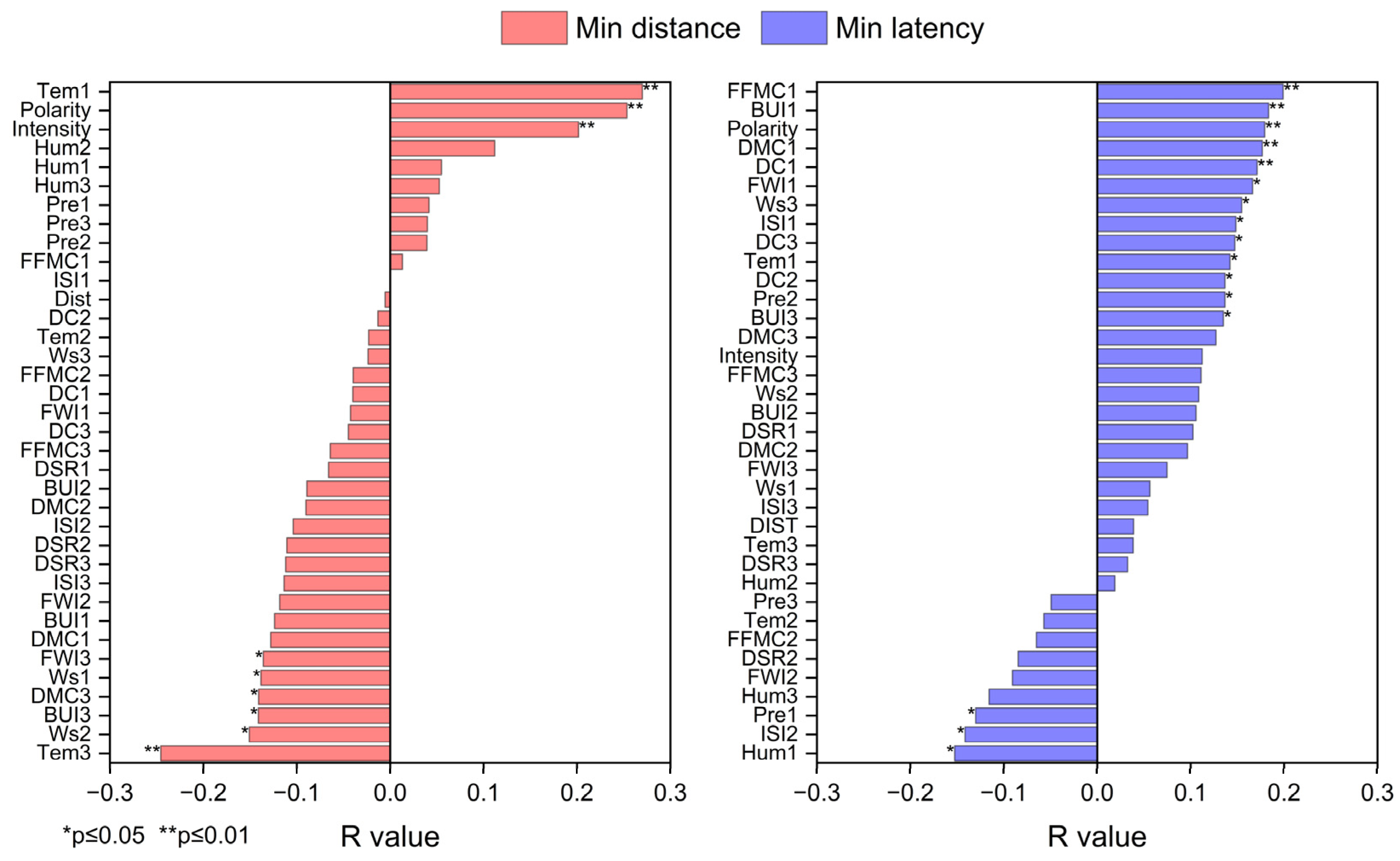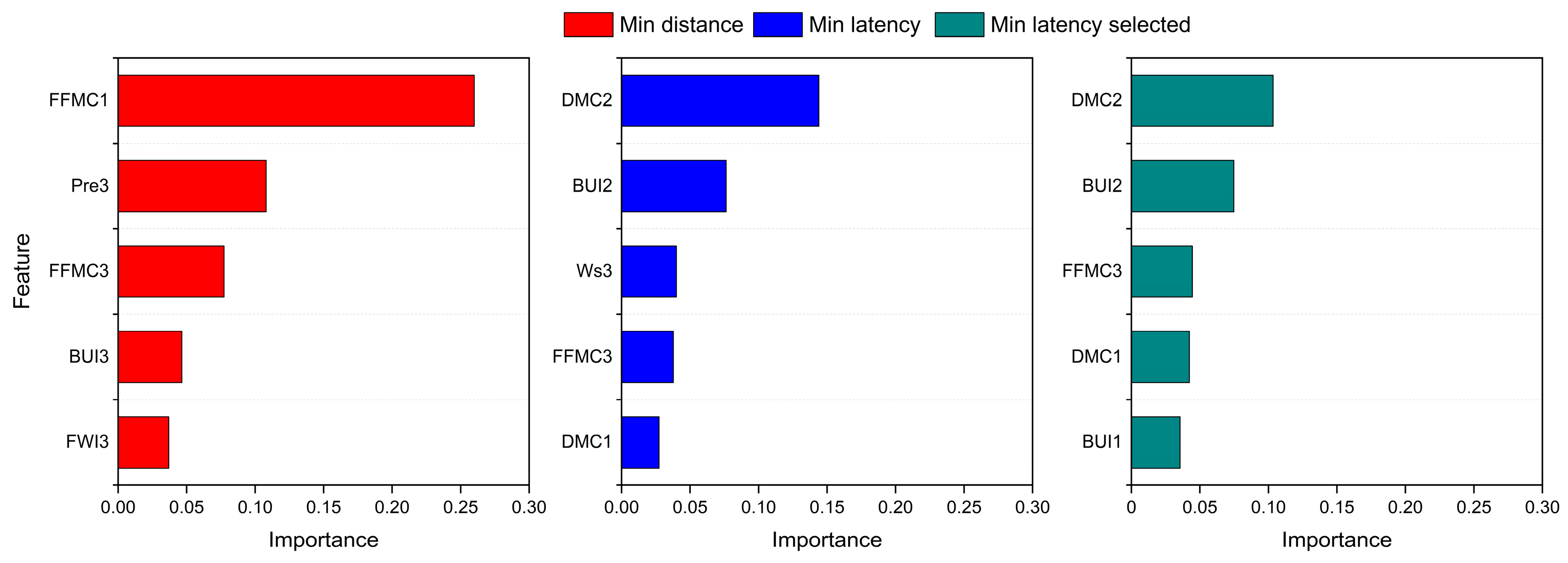Investigating the Latency of Lightning-Caused Fires in Boreal Coniferous Forests Using Random Forest Methodology
Abstract
1. Introduction
2. Materials and Methods
2.1. Overview of the Study Area
2.2. Data Source
2.3. Data Preprocessing
2.3.1. Ignition Lightning Determination Method
2.3.2. Meteorological Data
2.4. Research Method
2.4.1. FWI (Fire Weather Index)
- FFMC (Fine Fuel Moisture Code): Measures the moisture level of surface fine fuels (such as dead grass, needles, etc.).
- DMC (Duff Moisture Code): Measures the moisture level of the duff layer (the organic matter layer in forests).
- DC (Drought Code): Measures the impact of long-term drought on the deep organic matter layer.
- ISI (Initial Spread Index): Measures the rate of fire spread without wind influence.
- BUI (Buildup Index): Measures the accumulation and drying degree of fuels.
- FWI (Fire Weather Index): Provides a comprehensive evaluation of the fire weather danger level.
- DSR (Daily Severity Rating): Assesses the potential severity of fires.
2.4.2. Person Correlation Coefficient
2.4.3. RFM (Random Forest Model)
2.4.4. RFECV (Recursive Feature Elimination with Cross-Validation)
- Comprehensive Interaction Assessment: RFECV is capable of capturing high-order interactions among features. It achieves this by iteratively eliminating features that make the least contribution to the model, thereby progressively refining the feature subset. In contrast, the Filter method merely evaluates the linear correlation between individual variables and the target variable, and is unable to handle nonlinear relationships effectively.
- Model-Adaptability and Feature Subset Compatibility: RFECV relies on the weights of the base model as the basis for feature elimination. This ensures the compatibility of the selected feature subset with the final predictive model, thus avoiding the suboptimal feature subsets that may arise from the assumptions inherent in Embedded models.
- Robust Generalization Performance Evaluation: RFECV assesses the generalization performance of feature subsets at each recursive step through cross-validation. This significantly mitigates the impact of random fluctuations. In comparison, the Wrapper method is more prone to falling into local optimality due to the absence of cross–validation, which can lead to less reliable feature selection results.
- Interpretability and Feature Importance Classification: RFECV provides a clear sequence of feature elimination and supports the classification of factor importance. Moreover, the output feature subset maintains consistency with the physical meaning of the original variables, which represents a distinct advantage over black–box dimensionality reduction techniques such as Principal Component Analysis (PCA).
2.4.5. SHAP (Shapley Additive Explanations)
2.4.6. Data Analysis and Mapping
3. Results
3.1. Lightning and Lightning-Caused Fire Characteristics
3.2. Characteristics of Ignition Lightning
3.3. Correlation Analysis of Influencing Factors and Latency
3.4. RFM Evaluation and Feature Interpretation
4. Discussion
5. Conclusions
Author Contributions
Funding
Institutional Review Board Statement
Informed Consent Statement
Data Availability Statement
Acknowledgments
Conflicts of Interest
References
- Price, C.; Rind, D. Probable implications of global climate change on global lightning distributions and frequencies. J. Geophys. Res. Atmos. 1994, 99, 10823–10831. [Google Scholar]
- Reeve, N.; Toumi, R. Lightning activity as an indicator of climate change. Q. J. R. Meteorol. Soc. 1999, 125, 893–903. [Google Scholar] [CrossRef]
- Wotton, B.M.; Martell, D.L.; Logan, K.A. Climate change and people-caused forest fire occurrence in Ontario. Clim. Change 2003, 60, 275–295. [Google Scholar] [CrossRef]
- Krause, A.; Kloster, S.; Wilkenskjeld, S. The sensitivity of global wildfires to simulated past, present, and future lightning frequency. J. Geophys. Res. Biogeosci. 2014, 119, 312–322. [Google Scholar] [CrossRef]
- Fill, J.M.; Davis, C.N.; Crandall, R.M. Climate change lengthens southeastern USA lightning-ignited fire seasons. Glob. Chang. Biol. 2019, 25, 3562–3569. [Google Scholar] [CrossRef]
- Coogan, S.C.P.; Cai, X.; Jain, P.; Flannigan, M.D. Seasonality and trends in human- and lightning-caused wildfires ≥ 2 ha in Canada, 1959–2018. Int. J. Wildland Fire 2020, 29, 473–485. [Google Scholar] [CrossRef]
- Wang, Y.; Anderson, K.R. An evaluation of spatial and temporal patterns of lightning- and human-caused forest fires in Alberta, Canada, 1980–2007. Int. J. Wildland Fire 2010, 19, 1059–1072. [Google Scholar] [CrossRef]
- Shu, L.F.; Wang, M.Y.; Tian, X.R.; Li, Z.Q.; Xiao, Y.J. Fire environment mechanism of ground fire formation in Daxing’an Mountains. J. Nat. Disast. 2003, 12, 62–67. [Google Scholar]
- Tian, X.; Zhao, F.; Shu, L.; Wang, M. Distribution characteristics and the influence factors of forest fires in China. For. Ecol. Manag. 2013, 310, 460–467. [Google Scholar] [CrossRef]
- Flannigan, M.; Stocks, B.; Turetsky, M.; Wotton, M. Impacts of climate change on fire activity and fire management in the circumboreal forest. Glob. Change Biol. 2009, 15, 549–560. [Google Scholar] [CrossRef]
- Zhao, F.; Shu, L.; Di, X.; Tian, X.; Wang, M. Changes in the occurring date of forest fires in the Inner Mongolia Daxing’anling forest region under global warming. Sci. Silvae Sin. 2009, 45, 166–172. [Google Scholar]
- Tian, X.; Dai, X.; Wang, M.; Zhao, F.; Shu, L. Forest fire risk assessment for China under different climate scenarios. Chin. J. Appl. Ecol. 2016, 27, 769–776. [Google Scholar]
- Gao, C.; An, R.; Wang, W.; Shi, C.; Wang, M.; Liu, K.; Wu, X.; Wu, G.; Shu, L. Asymmetrical lightning fire season expansion in the boreal forest of Northeast China. Forests 2021, 12, 1023. [Google Scholar] [CrossRef]
- Zhang, H.; Guo, P.; Chen, H.; Liu, N.; Qiao, Y.; Xu, M.; Zhang, L. Lightning-induced smoldering ignition of peat: Simulation experiments by a lightning arc with long continuing current. Proc. Combust. Inst. 2023, 39, 4185–4193. [Google Scholar] [CrossRef]
- Liu, Z.; Yang, J.; Chang, Y.; Weisberg, P.J.; He, H.S. Spatial patterns and drivers of fire occurrence and its future trend under climate change in a boreal forest of Northeast China. Glob. Change Biol. 2012, 18, 2041–2056. [Google Scholar] [CrossRef]
- Ying, L.; Han, J.; Du, Y.; Shen, Z. Forest fire characteristics in China: Spatial patterns and determinants with thresholds. Forest Ecol. Manag. 2018, 424, 345–354. [Google Scholar] [CrossRef]
- Nash, C.H.; Johnson, E.A. Synoptic climatology of lightning-caused forest fires in subalpine and boreal forests. Can. J. For. Res. 1996, 26, 1859–1874. [Google Scholar] [CrossRef]
- Anderson, K. A model to predict lightning-caused fire occurrences. Int. J. Wildland Fire 2002, 11, 163–172. [Google Scholar] [CrossRef]
- Pineda, N.; Rigo, T. The rainfall factor in lightning-ignited wildfires in Catalonia. Agric. For. Meteorol. 2017, 239, 249–263. [Google Scholar] [CrossRef]
- Schultz, C.J.; Nauslar, N.J.; Wachter, J.B.; Hain, C.R.; Bell, J.R. Spatial, temporal, and lightning characteristics of lightning in reported lightning-initiated wildfire events. Fire 2019, 2, 18. [Google Scholar] [CrossRef]
- Wotton, B.M.; Martell, D.L. A lightning fire occurrence model for Ontario. Can. J. For. Res. 2005, 35, 1389–1401. [Google Scholar] [CrossRef]
- Duncan, B.W.; Adrian, F.W.; Stolen, E.D. Isolating the lightning ignition regime from a contemporary background fire regime in east-central Florida, USA. Can. J. For. Res. 2010, 40, 286–297. [Google Scholar] [CrossRef]
- Dowdy, A.J.; Mills, G.A. Characteristics of lightning-attributed wildland fires in south-east Australia. Int. J. Wildland Fire 2012, 21, 521–524. [Google Scholar] [CrossRef]
- Tian, X.-R.; Shu, L.-F.; Zhao, F.-J.; Wang, M.-Y.; McRae, D.J. Future impacts of climate change on forest fire danger in northeastern China. J. For. Res. 2011, 22, 437. [Google Scholar] [CrossRef]
- Moris, J.V.; Conedera, M.; Nisi, L.; Bernardi, M.; Cesti, G.; Pezzatti, G.B. Lightning-caused fires in the Alps: Identifying the igniting strokes. Agric. For. Meteorol. 2020, 290, 107990. [Google Scholar] [CrossRef]
- Taylor, S.W.; Alexander, M.E. Science, technology, and human factors in fire danger rating: The Canadian experience. Int. J. Wildland Fire 2006, 15, 121–133. [Google Scholar] [CrossRef]
- Turner, J.A.; Lawson, B.D. Weather in the Canadian Forest Fire Danger Rating System: A User Guide to National Standards and Practices; Information Report BC-X-177; Fisheries and Environment Canada, Canadian Forest Service, Pacific Forest Research Centre: Victoria, BC, Canada, 1978. [Google Scholar]
- Tian, X.R.; McRae, D.J.; Jin, J.Z. Changes of forest fire danger and the evaluation of the FWI System application in the Daxing’anling region. Sci. Silvae Sin. 2010, 46, 127–132. [Google Scholar]
- Breiman, L. Random forests. Mach. Learn. 2001, 45, 5–32. [Google Scholar] [CrossRef]
- Misra, P.; Yadav, A.S. Improving the classification accuracy using recursive feature elimination with cross-validation. Int. J. Emerg. Technol. 2020, 11, 659–665. [Google Scholar]
- Mangalathu, S.; Hwang, S.H.; Jeon, J.S. Failure mode and effects analysis of RC members based on machine-learning-based SHapley Additive exPlanations (SHAP) approach. Eng. Struct. 2020, 219, 110927. [Google Scholar] [CrossRef]
- Taylor, A.R. Tree-Bole Ignition in Superimposed Lightning Scars; American Academic Press: New York, NY, USA, 1969. [Google Scholar]
- Flannigan, M.D.; Wotton, B.M. Lightning-ignited forest fires in northwestern Ontario. Can. J. For. Res. 1991, 21, 277–283. [Google Scholar] [CrossRef]
- Nieto, H.; Aguado, I.; García, M. Lightning-caused fires in Central Spain: Development of a probability model of occurrence for two Spanish regions. Agric. For. Meteorol. 2012, 162-163, 35–43. [Google Scholar] [CrossRef]
- Huang, X.; Rein, G. Upward-and-downward spread of smoldering peat fire. Proc. Combust. Inst. 2019, 37, 4025–4033. [Google Scholar] [CrossRef]
- Abatzoglou, J.T.; Williams, A.P.; Barbero, R. Global emergence of anthropogenic climate change in fire weather indices. Geophys. Res. Lett. 2019, 46, 326–336. [Google Scholar] [CrossRef]
- Williams, A.P.; Abatzoglou, J.T.; Gershunov, A.; Guzman-Morales, J.; Bishop, D.A.; Balch, J.K.; Lettenmaier, D.P. Observed impacts of anthropogenic climate change on wildfire in California. Earth’s Future 2019, 7, 892–910. [Google Scholar] [CrossRef]
- Duane, A.; Castellnou, M.; Brotons, L. Towards a comprehensive look at global drivers of novel extreme wildfire events. Clim. Chang. 2021, 165, 43. [Google Scholar] [CrossRef]










Disclaimer/Publisher’s Note: The statements, opinions and data contained in all publications are solely those of the individual author(s) and contributor(s) and not of MDPI and/or the editor(s). MDPI and/or the editor(s) disclaim responsibility for any injury to people or property resulting from any ideas, methods, instructions or products referred to in the content. |
© 2025 by the authors. Licensee MDPI, Basel, Switzerland. This article is an open access article distributed under the terms and conditions of the Creative Commons Attribution (CC BY) license (https://creativecommons.org/licenses/by/4.0/).
Share and Cite
Li, W.; Shu, L.; Wang, M.; Si, L.; Li, W.; Song, J.; Yuan, S.; Wang, Y.; Zhao, F. Investigating the Latency of Lightning-Caused Fires in Boreal Coniferous Forests Using Random Forest Methodology. Fire 2025, 8, 84. https://doi.org/10.3390/fire8020084
Li W, Shu L, Wang M, Si L, Li W, Song J, Yuan S, Wang Y, Zhao F. Investigating the Latency of Lightning-Caused Fires in Boreal Coniferous Forests Using Random Forest Methodology. Fire. 2025; 8(2):84. https://doi.org/10.3390/fire8020084
Chicago/Turabian StyleLi, Wei, Lifu Shu, Mingyu Wang, Liqing Si, Weike Li, Jiajun Song, Shangbo Yuan, Yahui Wang, and Fengjun Zhao. 2025. "Investigating the Latency of Lightning-Caused Fires in Boreal Coniferous Forests Using Random Forest Methodology" Fire 8, no. 2: 84. https://doi.org/10.3390/fire8020084
APA StyleLi, W., Shu, L., Wang, M., Si, L., Li, W., Song, J., Yuan, S., Wang, Y., & Zhao, F. (2025). Investigating the Latency of Lightning-Caused Fires in Boreal Coniferous Forests Using Random Forest Methodology. Fire, 8(2), 84. https://doi.org/10.3390/fire8020084




